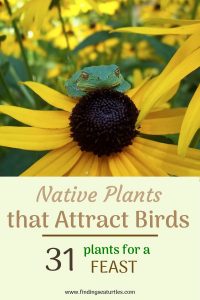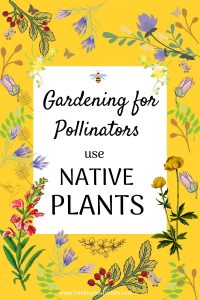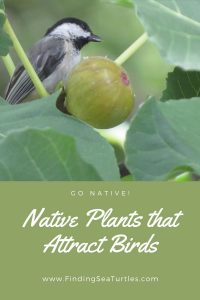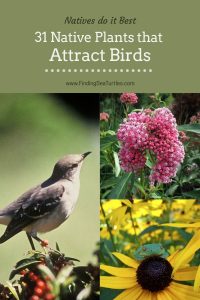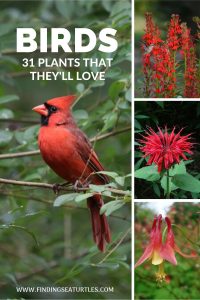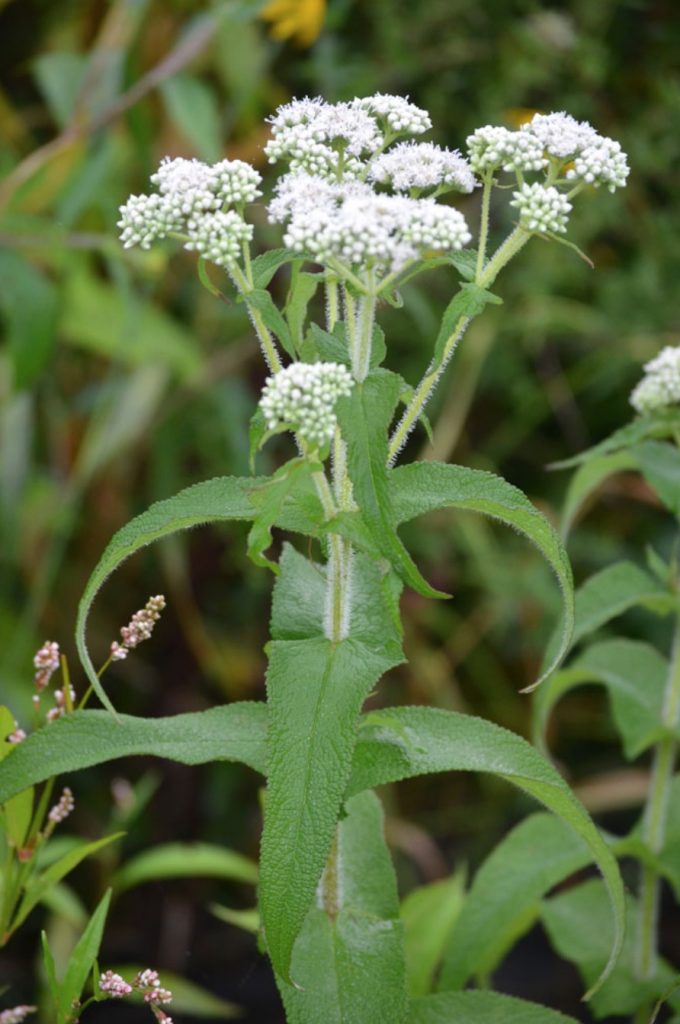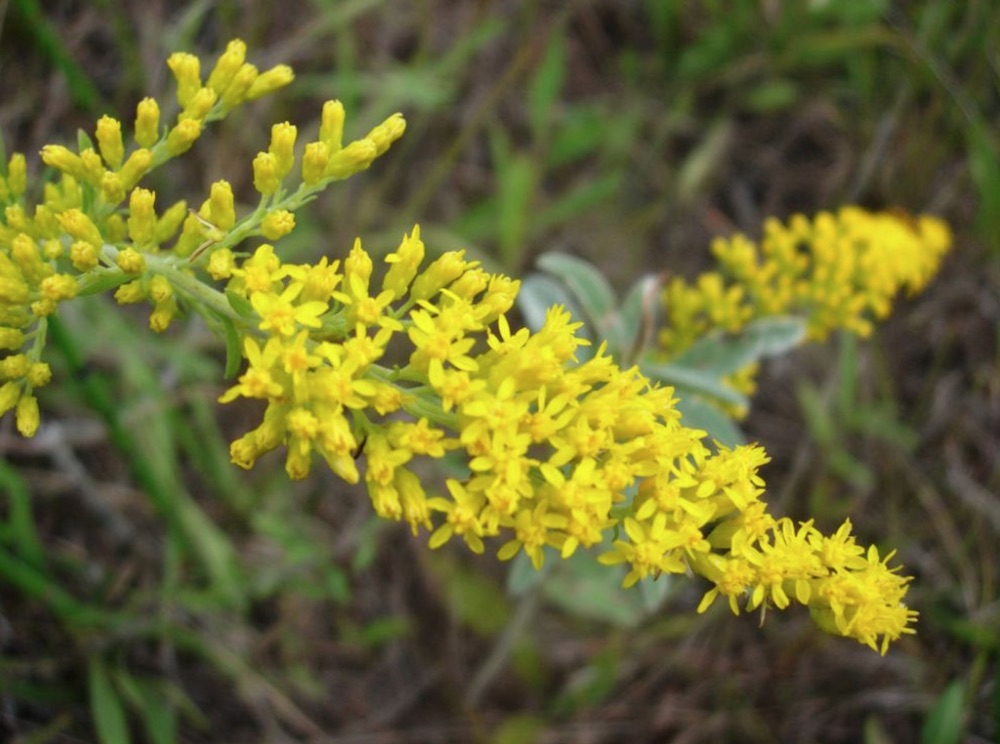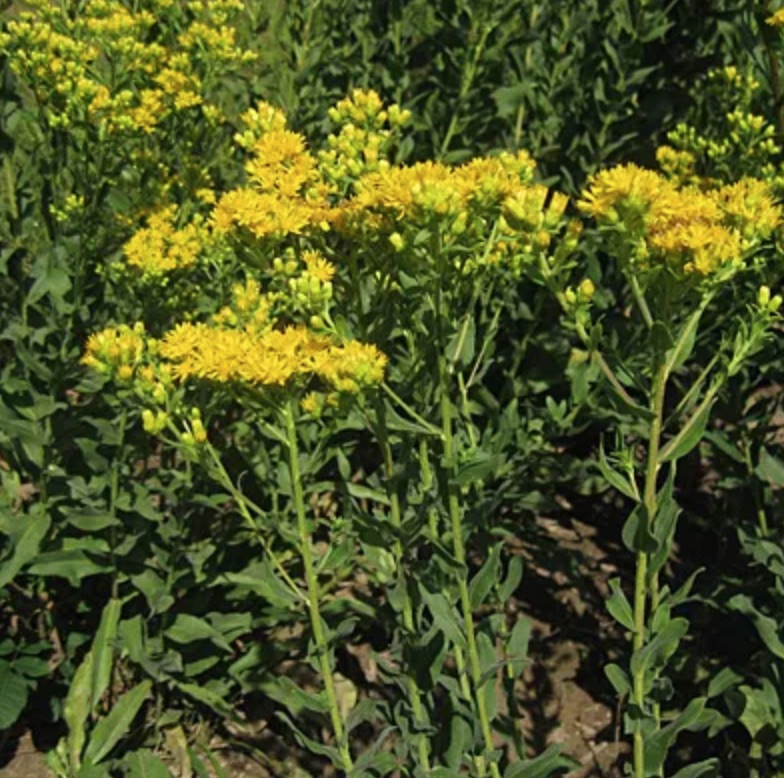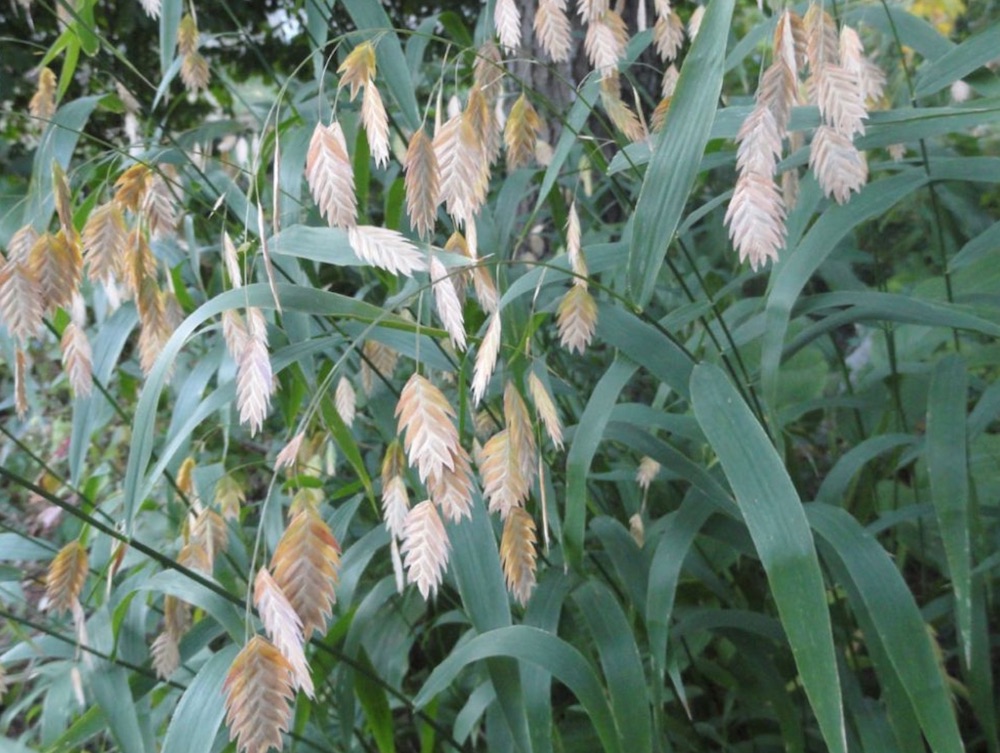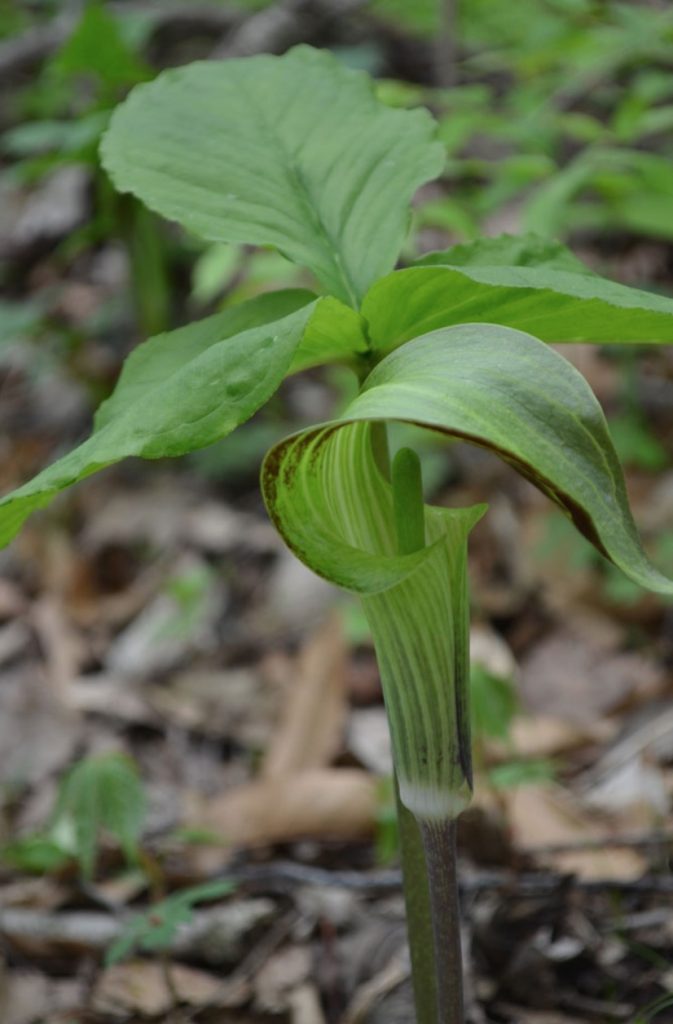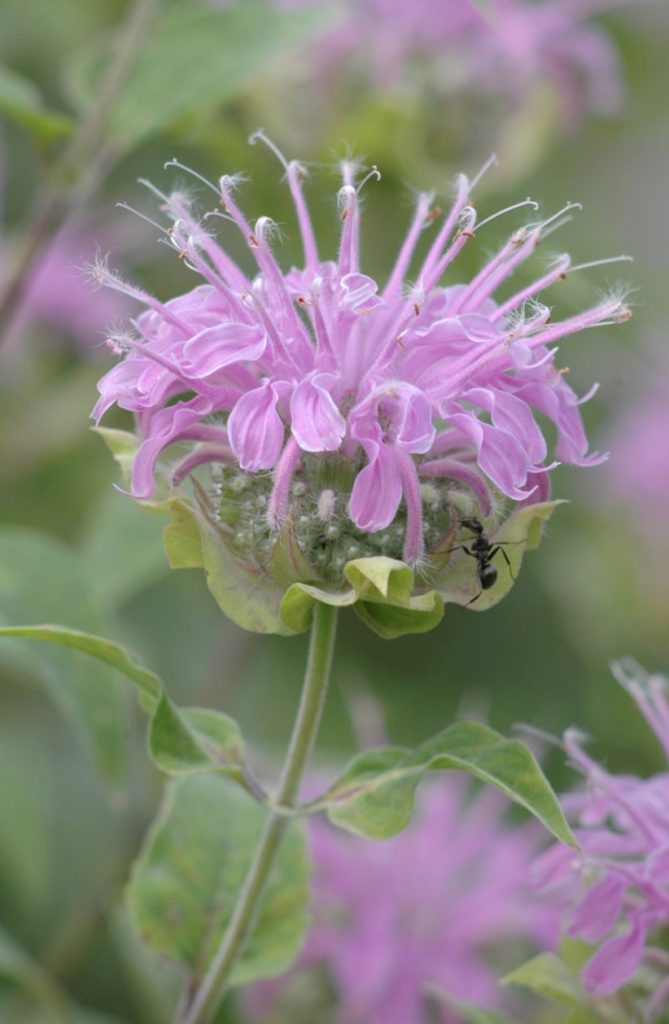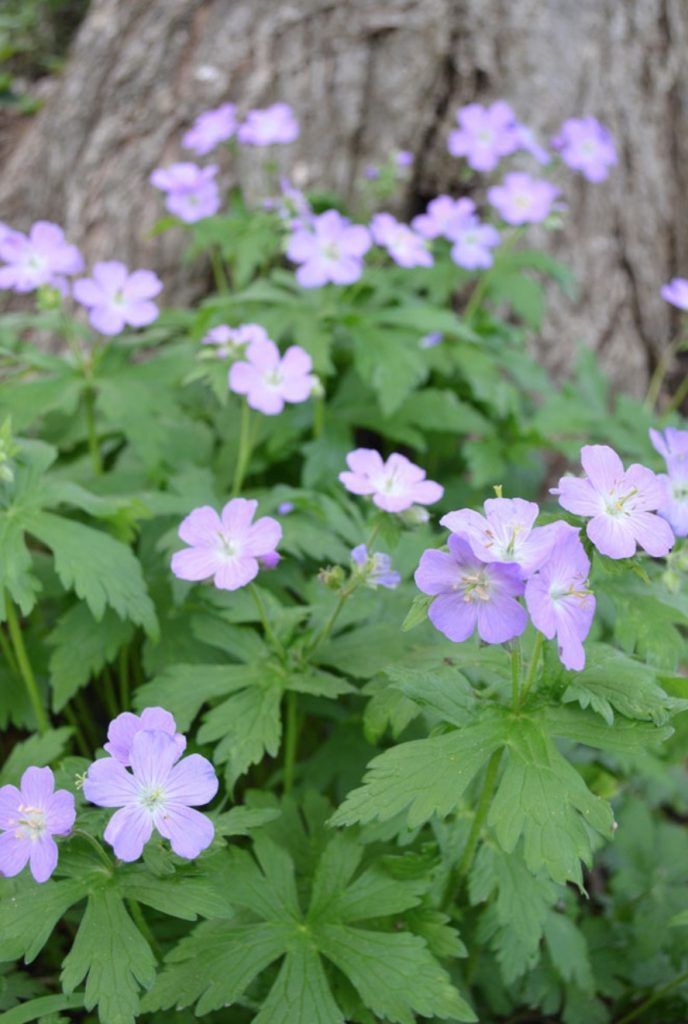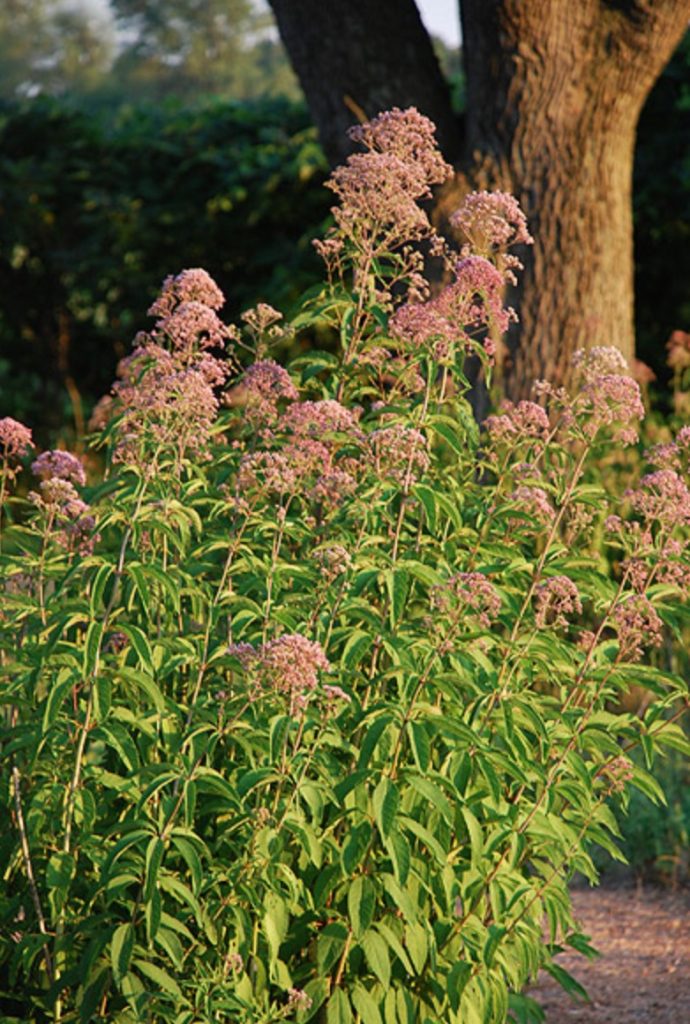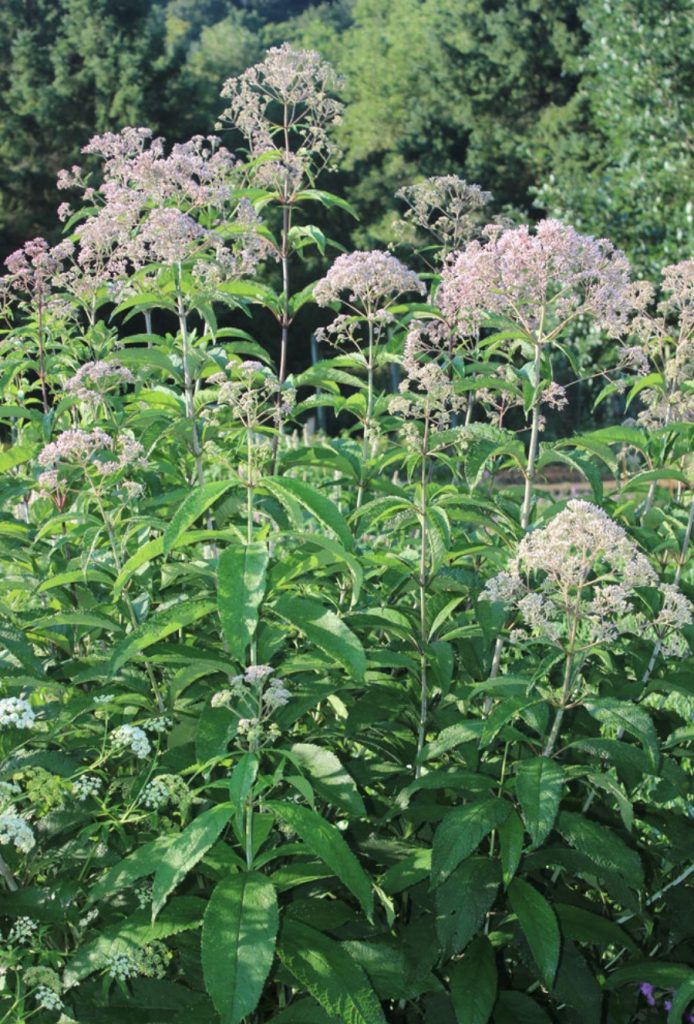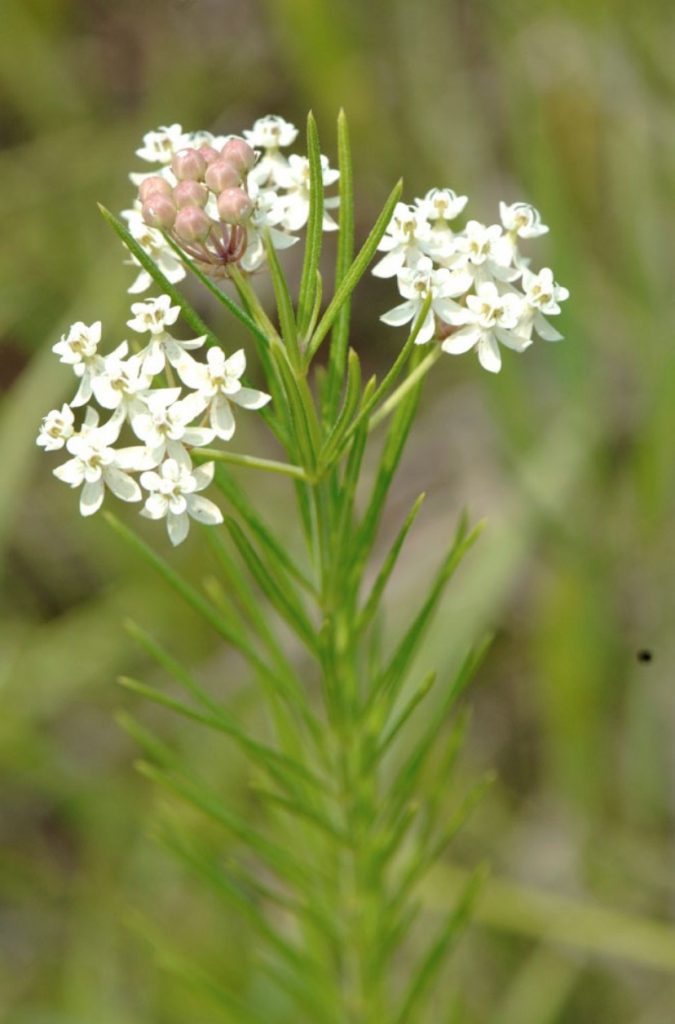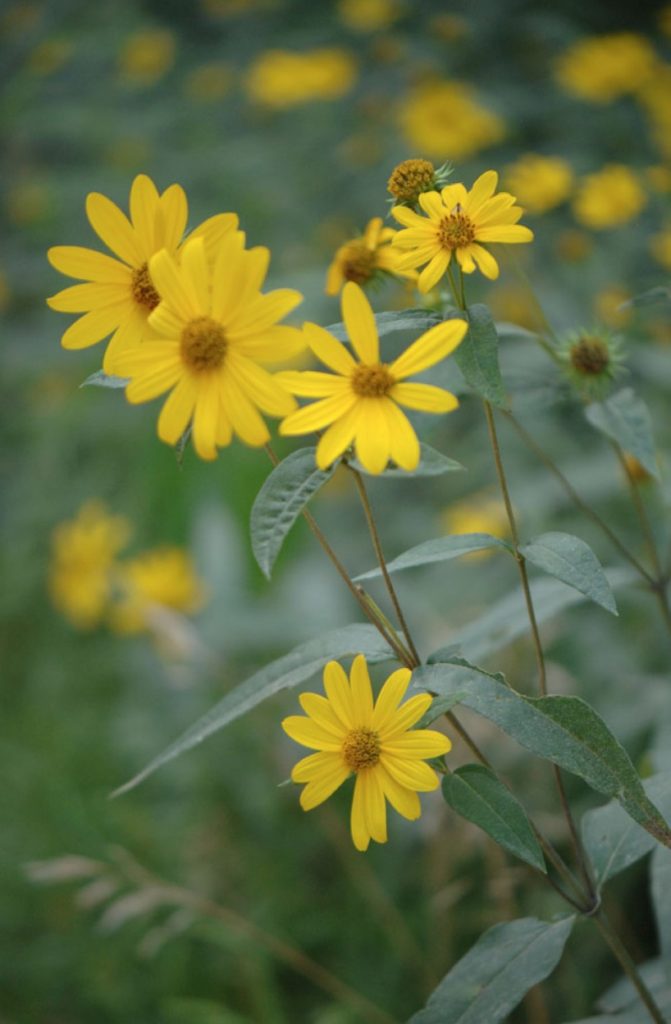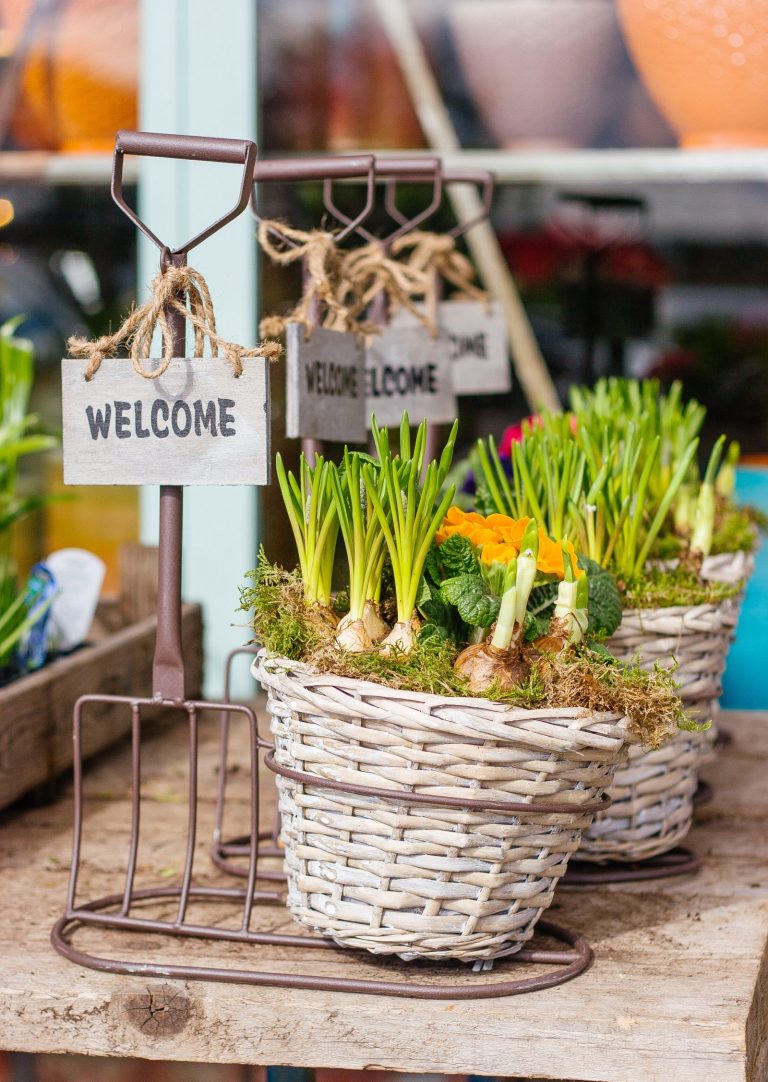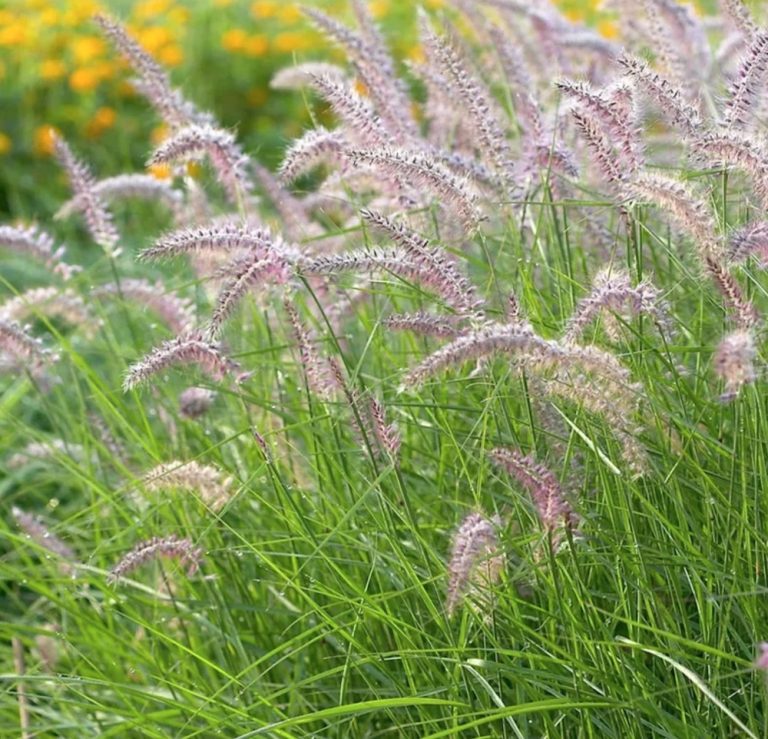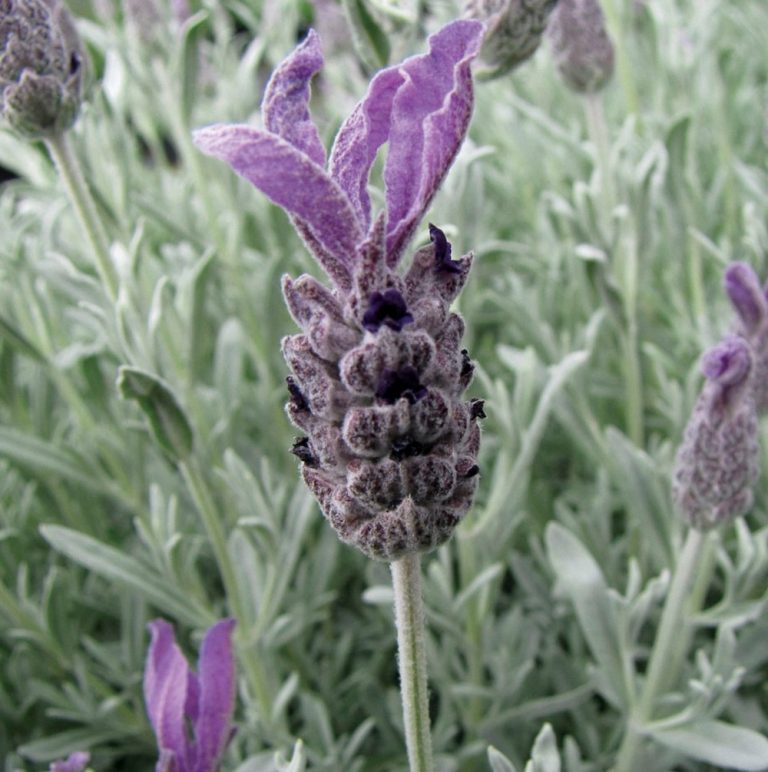Native Plants that Attract Birds
Go native, that is . . . use native plants that attract birds. Native plants are a natural lure for birds and all wildlife. Birds naturally gravitate towards native plants. And when planted, native plants tend to transition more quickly to its surrounding than non-native plants. The transition period is shorter and they don’t need the attention that many non-native plants need. After all, this is their native habitat.
Take a look at our list of native plants that attract birds.
-
Black-Eyed-Susan Rudbeckia hirta
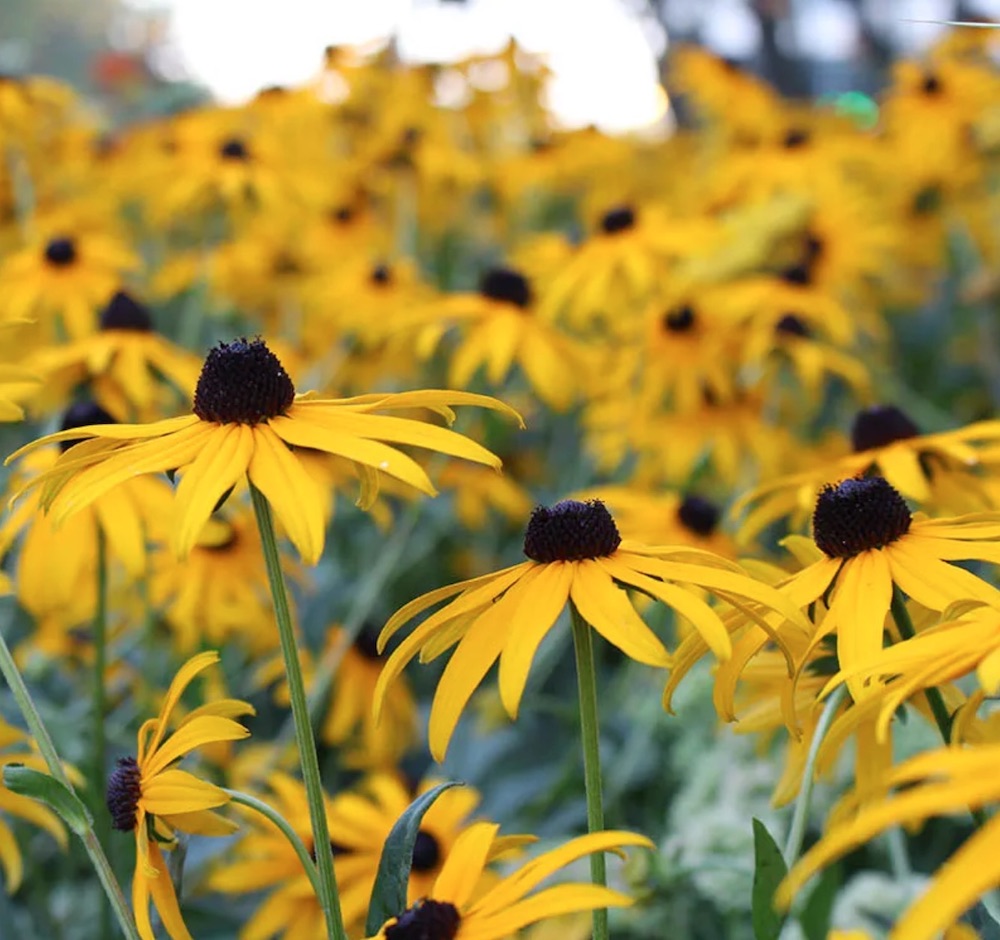
Black-Eyed-Susan Rudbeckia hirta
- Native
- Grows in zones 3 to 8
- Part shade and part Sun to full Sun
- Reaches 12 to 36 inches tall
- Sunny Golden Yellow blooms
- Blooms from Summer into the Fall season
- Attracts butterflies and birds
- Resistant to both deer and rabbits
- Use cut flowers in a floral arrangement
- Grow in containers
- Tolerates sandy, loamy, clay, dry, and moist wet soil conditions
- Tolerant of drought conditions once established
Planted in many American gardens and meadows, a versatile long blooming native with a strong Winter presence. For a companion planting partner, plant with Purple Coneflowers. As an all time favorite, Black-Eyed Susan is a dependable native plant that birds love. Birds that you may see around the Black-eyed Susan Rudbeckia are:
Blue Jays * Crows * Chickadees and Titmice * Cardinals and Grosbeaks * Mockingbirds and Thrashers * Nuthatches * Orioles * Sparrows * Thrushes * Vireos * Waxwings * Woodpeckers * Wood Warblers * Wrens
2. Butterfly Milkweed Asclepias tuberosa
Butterfly Milkweed Asclepias tuberosa
- Native
- Grows in zones 3 to 9
- Full Sun
- Reaches 24 inches tall
- Fragrant cluster blooms of bright Orange to Yellow-orange
- Blooms in the Summer
- Attracts pollinators including bees, butterflies, birds, and hummingbirds
- Resistant to deer
- Use in a floral arrangement
- Tolerates sandy, loamy, and moist soil conditions
- Tolerant of drought conditions once established
- Host plant for butterfly species including the Monarch
As Wit’s End Gardens says Natives do it best! This nectar rich perennial is also known as Orange Milkweed and Pleurisy Root. Butterfly Milkweed is an important native plant for birds and wildlife in general. Some birds that you might see around the Orange Milkweed are:
Blue Jays * Crows * Chickadees & Titmice * Cardinals & Grosbeaks * Finches * Hummingbirds * Mockingbirds & Thrashers * Nuthatches * Orioles * Sparrows * Thrushes * Vireos * Waxwings * Woodpeckers Wood Warblers * Wrens
3. Cardinal-Flower Lobelia cardinalis
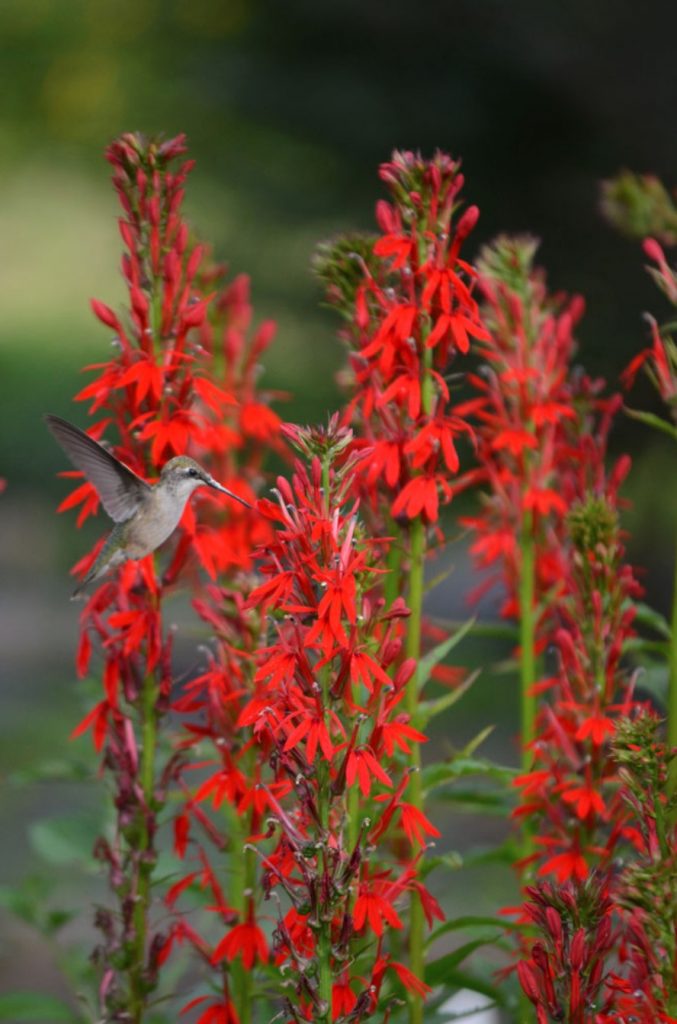
Cardinal-Flower Lobelia cardinalis
- Native
- Grows in zones 4 to 9
- Part shade and part Sun to full Sun.
- Reaches around 4 feet tall
- Scarlet red flowers
- Blooms from July, August, through September months
- Attracts bees, butterflies, and hummingbirds
- Resistant to deer
- Tolerates moist wet soil conditions
A nectar source for swallowtail butterflies and hummingbirds, this showy red flower is a self-seeder with a fast growth rate. Use as a cut flower in arrangements. For a companion planting partner, plant Great Blue Lobelia with the Cardinal Flower. A favorite of birds, you may see some of the following around the Cardinal flower plant:
Blue Jays * Crows * Chickadees and Titmice * Cardinals and Grosbeaks * Hummingbirds * Mockingbirds and Thrashers * Nuthatches * Orioles * Sparrows * Thrushes * Vireos * Waxwings * Woodpeckers * Wood Warblers * Wrens
4. Common Boneset Eupatorium perfoliatum
Common Boneset Eupatorium perfoliatum
- Native
- Grows in zones 3 to 8
- Part shade and part Sun to full Sun
- Tops out at 4 feet tall
- White flowers heads are flat to roundish
- Blooms in July, August, and continues through September
- Attracts bees, butterflies, and birds
- Resistant to deer
- Tolerates moist wet soil conditions
A pollinator garden favorite of several insect species and birds. As a companion to Common Boneset plant Dense Blazing Star. Birds that may be seen around the Common Boneset are:
Blue Jays * Crows * Chickadees and Titmice * Cardinals and Grosbeaks * Mockingbirds and Thrashers * Nuthatches * Orioles * Sparrows * Thrushes * Vireos * Waxwings * Woodpeckers * Wood Warblers * Wrens
5. Common Milkweed Asclepias syriaca

Common Milkweed Asclepias syriaca
- Native
- Grows in zones 3 to 9
- Reaches 48 inches tall
- Full Sun
- Fragrant pink to purple blooms
- Blooms in the Summer
- Attracts pollinators including bees, butterflies, birds, and hummingbirds
- Resistant to deer
- Use in a floral arrangement
- Tolerates sandy, loamy, rocky, and clay soil conditions
- Tolerant of drought conditions once established
- Host plant for butterfly species including the Monarch
Common milkweed with rose colored floral balls that develop into yummy seed pods. As the Fall season approaches, the seed pods provide an excellent source of food for wildlife. A valuable host plant for Monarch butterflies however, the milky sap can be poisonous if large quantities are ingested. Some of the birds that can be seen around the common milkweed are:
Blue Jays * Crows * Chickadees and Titmice * Cardinals and Grosbeaks * Finches * Mockingbirds and Thrashers * Nuthatches * Orioles * Sparrows * Thrushes * Vireos * Waxwings * Woodpeckers * Wood Warblers * Wrens
6. Red Yarrow Achillea millefolium
- Native
- Grows in zones 4 to 8
- Part shade and part Sun to full Sun
- Reaches 24 to 36 inches tall and wide
- Fragrant deep rose-red, flat topped flower heads
- Deep green fine textured foliage
- Blooms in the Summer
- Bee friendly attracts butterflies, and birds.
- Resistant to deer and rabbits
- Tolerates sandy, loamy, and clay soil conditions
- Tolerant of drought conditions once established, Waterwise
- Aids in erosion control
Red Velvet Yarrow is also known as Western Yarrow and Milfoil. As a companion plant, add Liatris Dense Blazing Star next to the Red Velvet. Birds that you might see around the Red Velvet Yarrow are:
Blue Jays * Crows * Chickadees and Titmice * Cardinals and Grosbeaks Finches * Mockingbirds and Thrashers * Orioles * Sparrows * Vireos * Waxwings * Woodpeckers * Wood Warblers
7. Dense Gayfeather Liatris spicata
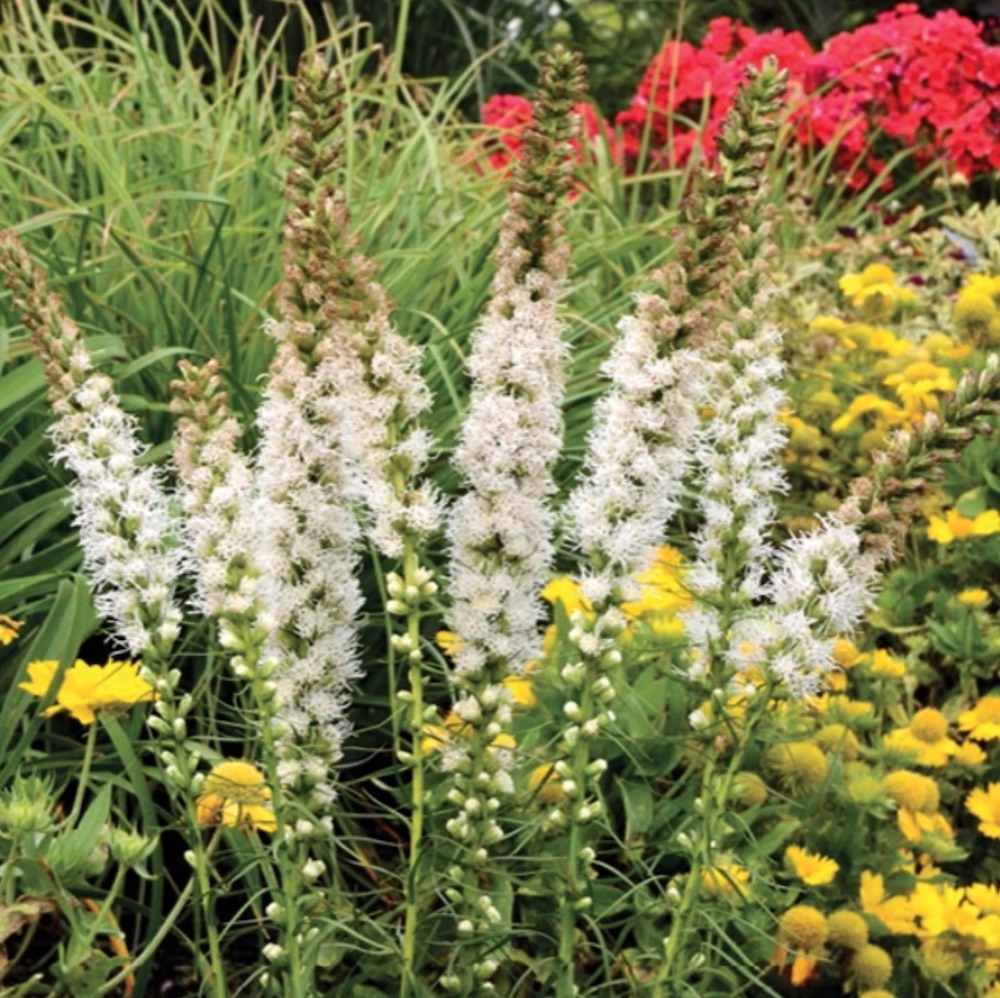
Floristan White
- Native
- Grows in zones 3 to 9
- Full Sun
- Reaches between 38 to 42 inches tall
- Tall spikes of white blooms
- Blooms during the Summer
- Bee friendly that attracts pollinators such as butterflies, birds, and hummingbirds
- Use in floral bouquets or dried floral arrangements
After the blooms have finished, the spikes develop seeds which attract goldfinches and chickadees. Floristan White is also known as Blazing Star, Marsh Blazing Star, and Gayfeather.
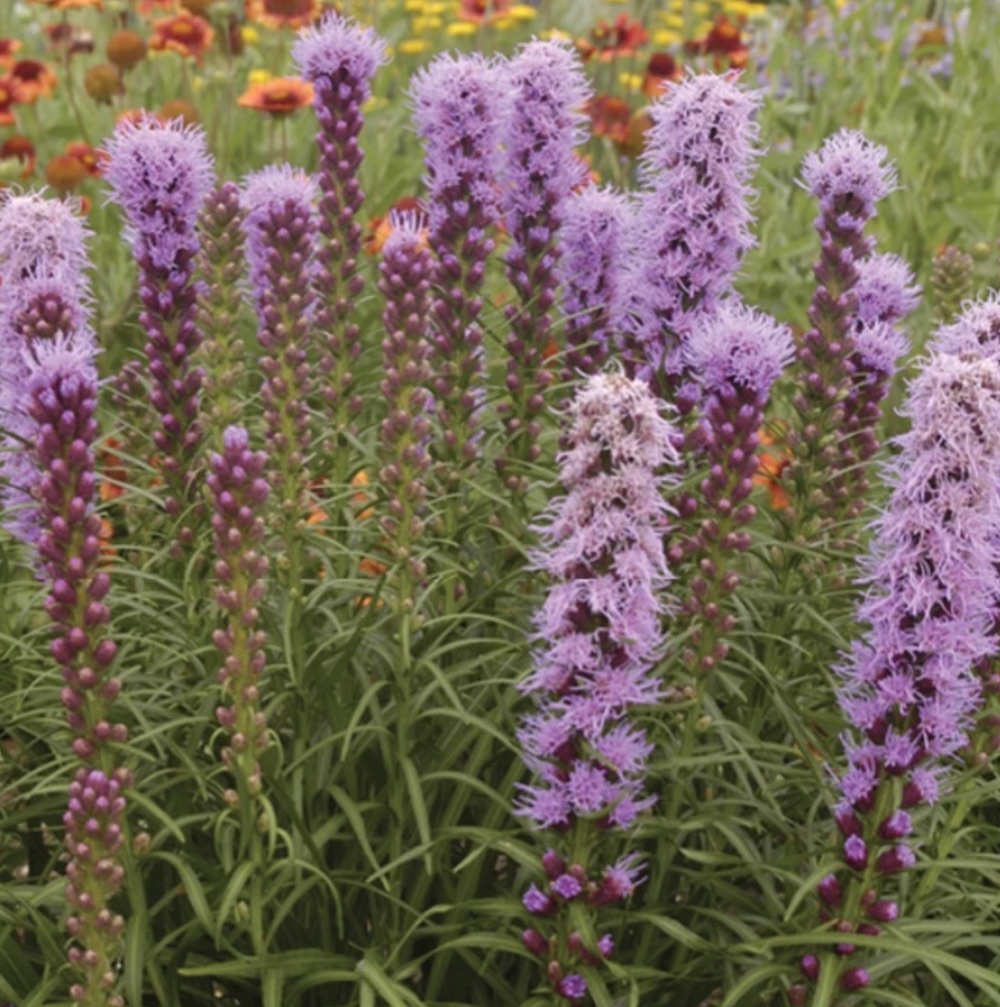
Kobold Liatris
- Native
- Grows in zones 3 to 9
- Full Sun
- Reaches 24 inches tall
- Purple lavender spikes blooms
- Bloom over the Summer months
- Bee friendly plant that attracts pollinators including butterflies, birds, and hummingbirds
A native “wildflower” fits in nicely as a border planting, meadow, or a prairie garden. Kobold Liatris is also called Blazing Star and Gayfeather. At the end of the flowering season, you’ll see a few songbirds feasting on the flower heads filled with seeds. Around the liatris, you may see some of these birds:
Hummingbirds * Mockingbirds * Orioles * Sparrows * Thrashers * Vireos * Waxwings * Wood Warblers
8. Calico Aster Symphyotrichum lateriflorum
- Native
- Grows in zones 3 to 9
- Shade to part shade and part Sun to full Sun
- Reaches 2 feet tall
- White and purple blooms
- Blooms beginning in August and continue through October
- Bee friendly plants that attract birds
- Resistant to deer
- Tolerates moist wet soil conditions
The Calico Aster is sometimes called Side-flowering Aster and Goblet Aster. The botanical name is Aster lateriflorus. A variety of insects are attracted the the shorter nectar tubes of this Aster. The types of birds you may see by the Aster are:
Blue Jays * Crows * Cardinals & Grosbeaks * Chickadees & Titmice * Finches * Mockingbirds & Thrashers * Nuthatches * Orioles * Sparrows * Thrushes * Vireos * Waxwings * Wood Warblers *
9. Old Field Goldenrod Solidago nemoralis
Old Field Goldenrod Solidago nemoralis
- Native
- Grows in zones 3 to 9
- Part shade and part Sun to full Sun
- Reaches 2 feet tall
- Golden yellow blooms
- Blooms in August and September
- Bee friendly plant that attracts birds
- Resistant to deer
- Tolerant of sandy, rocky, clay, and poor soil conditions
- Plant on slopes or banks
Old Field Goldenrod is also called Prairie, Gray, Grayleaf, Dyersweed, Dwarf, and Field Goldenrod. Draws birds to its golden yellow blooms. A few of the birds you may see include:
Blue Jays * Crows * Chickadees & Titmice * Cardinals & Grosbeaks * Finches * Mockingbirds & Thrashers * Nuthatches * Orioles * Sparrows * Thrushes * Vireos * Waxwings * Woodpeckers Wood Warblers * Wrens
10. Great Blue Lobelia Lobelia siphilitica
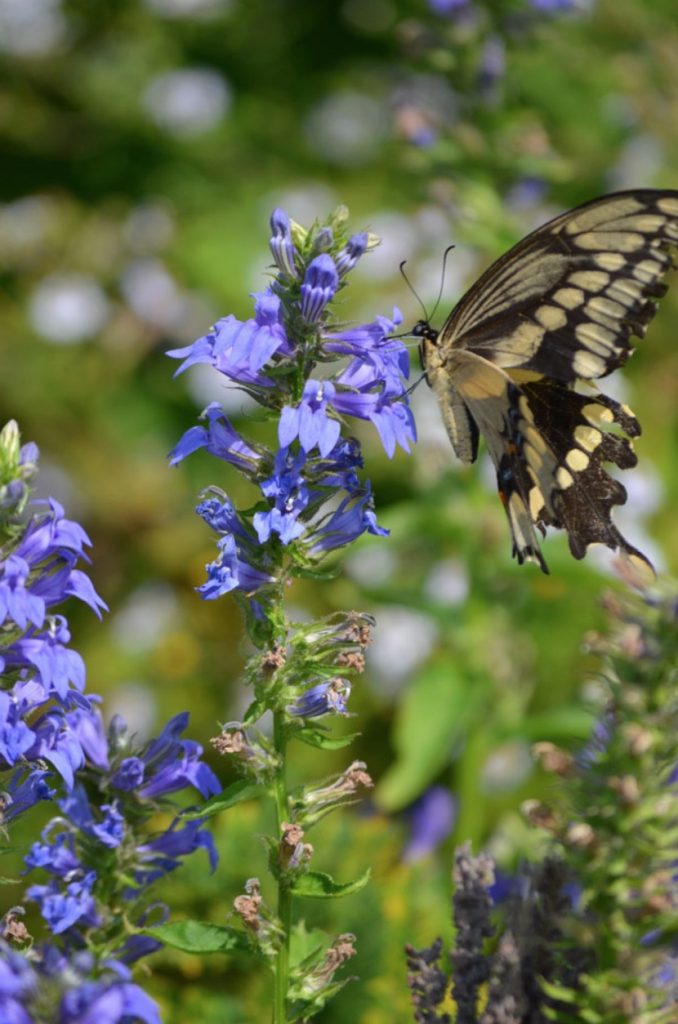
Great Blue Lobelia Lobelia siphilitica
- Native
- Grows in zones 3 to 9
- Part shade and part Sun to full Sun
- Reaches 3 feet tall
- Lavender blue tubular blooms
- Blooms from July, August, September, and continues through October
- Bee friendly plants that attract birds and hummingbirds
- Resistant to deer
- Tolerant of sandy, loam, and clay soil conditions
Companion plant pairs well with Pale Spiked Lobelia. Soil conditions must be moist or wet. Birds that are attracted to the Great Blue Lobelia are:
Blue Jays * Crows * Chickadees & Titmice * Cardinals & Grosbeaks * Hummingbirds * Mockingbirds & Thrashers * Orioles * Sparrows * Thrushes * Vireos * Waxwings * Woodpeckers * Wood Warblers * Wrens
11. Wild Golden Glow Rudbeckia laciniata
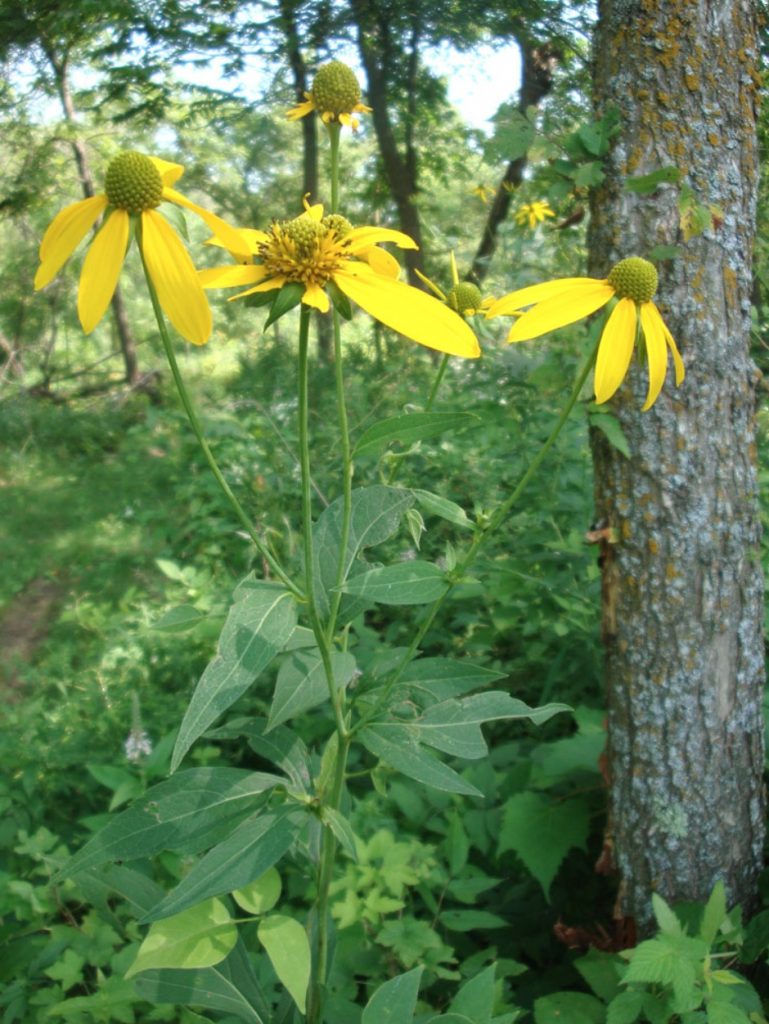
- Native
- Grows in zones 3 to 8
- Full shade to part shade and part Sun to full Sun
- Reaches 7 feet tall
- Yellow blooms with back-tilted petals with greenish cone-shaped centers
- Blooms from July, August, September, and through October
- Bee friendly perennial that attracts many variety of birds
- Prefers moist, slightly acidic soil conditions
- Resistant to deer
Wild Golden Glow is also known as Cut-leaved Coneflower, Cutleaf Coneflower, Green-headed Coneflower, Sochan, and Tall Coneflower. In the Fall, the cone-shaped centers turn dark and provide tasty seeds for the wildlife. A few of the birds you may see around the Wild Golden Glow are:
Blue Jays * Crows * Chickadees & Titmice * Cardinals & Grosbeaks * Mockingbirds & Thrashers * Nuthatches * Orioles * Sparrows * Thrushes * Vireos * Waxwings * Woodpeckers Wood Warblers * Wrens
12. Stiff Goldenrod Solidago
- Native
- Grows in zones 3 to 9
- Full Sun
- Reaches 36 to 60 inches tall
- Small daisy-like yellow blooms
- Blooms from August through September
- Tolerates loamy and clay soil conditions
- Bee friendly plant that attracts butterflies and birds
- Resistant to both deer and rabbits
- Tolerant of drought conditions once established, Waterwise
Perennial Stiff Goldenrod, is also known as Hard-Leaf Flat-Top-Goldenrod Solidago rigida. A few of the birds that you may see around this Goldenrod are:
Blue Jays * Crows * Chickadees & Titmice * Cardinals & Grosbeaks * Finches * Mockingbirds & Thrashers * Nuthatches * Orioles * Sparrows * Thrushes * Vireos * Waxwings * Woodpeckers * Wood Warblers * Wrens
13. River Oats Chasmanthium latifolium
- Native
- Grows in zones 4 to 9
- Part shade and part Sun
- Reaches 3 feet tall
- Blooms appear in July, August, and September
- Tolerates moist sands, loams, and clay soil condition
- Tolerant of shade conditions
River Oats is an ornamental grass that is also known as River, Flathead, Upland, Uniola latifolia, Northern Sea Oats, and Inland Sea Oats. In the Fall, the foliage and seed ripen from green to golden-brown with seeds persisting into the Winter. Tolerant of drought conditions once established. And tolerates periodic inundation. Birds that are drawn to the River Oats grass are:
Blue Jays * Crows * Chickadees & Titmice * Cardinals & Grosbeaks * Finches * Nuthatches * Sparrows * Woodpeckers
14. Jack-in-the-Pulpit Arisaema triphyllum
Jack-in-the-Pulpit Arisaema triphyllum
- Native
- Grows in zones 3 to 9
- Full shade to part shade and part Sun
- Reaches 2 feet high
- Hooded green flower with brown stripes flower
- Blooms April, May, June, and through July
- Bright red berries appear in late Summer
- Attracts birds
- Resistant to Deer
A fantastic woodland garden plant that does best in rich shady soil. The “jack” is a spongy cylindrical within the leaf-life flower rolled into a deep cup with an overhanging roof. Often referred to as the “Pulpit”. Over the late Summer, the Jack-in-the-Pulpit berries will be craved by these birds:
Blue Jays * Crows * Chickadees & Titmice * Cardinals & Grosbeaks * Finches * Sparrows * Woodpeckers
15. Common Evening Primrose
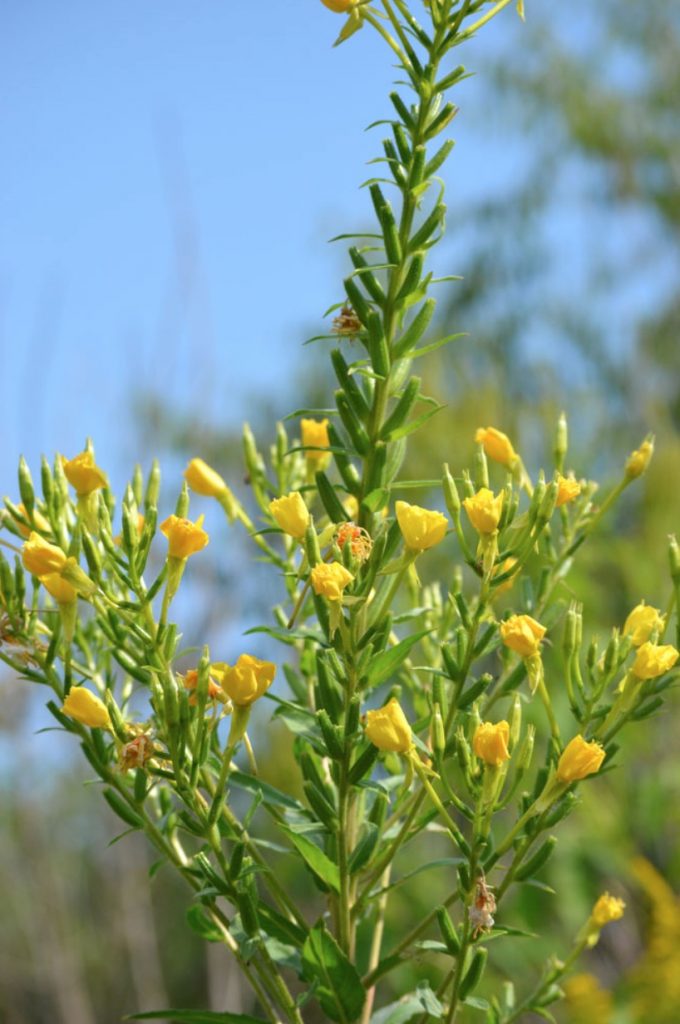
- Native
- Biennial wildflower reseeding itself
- Grows in part shade and part Sun to full Sun
- Reaches 6 feet tall
- Yellow flowers on spikes
- Blooms beginning in June and continue through November
- Resistant to deer
- Bee friendly biennial that attracts moths, butterflies, birds
- Tolerates dry, rocky and sandy soil conditions
The Common Evening-Primrose, also known as King’s-Cureall Oenothera biennis is an important native plant. It provides nectar well into the Fall months for wildlife. After the flowers have finished blooming, seeds develop that provide food for the birds. Some birds that you may see near the common evening primrose are:
Blue Jays * Crows * Chickadees & Titmice * Cardinals & Grosbeaks * Finches * Mockingbirds & Thrashers * Nuthatches * Orioles * Sparrows * Thrushes * Vireos * Waxwings * Woodpeckers Wood Warblers * Wrens
16. Wild Bergamot Monarda fistulos
Wild Bergamot Monarda fistulos
- Native
- Grows in zones 3 to 9
- Part shade and part Sun to full Sun
- Reaches 4 feet
- Fragrant violet purple tube-like blooms
- Blooms begin in July, August, and continue through September
- Bee friendly plant that attracts butterflies and hummingbirds
Wild Bergamot or Monarda fistulosa is also called Bee Balm, Oswego Tea, and Horse-Mint. For companion plants, plant Rudbeckia, Silphium, or Helianthus nearby. Wild Bergamot attracts many types of birds including some of these:
Blue Jays * Crows * Chickadees & Titmice * Cardinals & Grosbeaks * Hummingbirds * Mockingbirds & Thrashers * Nuthatches * Orioles * Sparrows * Thrushes * Vireos * Waxwings * Woodpeckers Wood Warblers * Wrens
17. Columbine Aquilegia canadensis

Columbine Aquilegia canadensis
- Native
- Grows in zones 3 to 8
- Full shade to part shade and part Sun to full Sun
- Reaches 2 feet tall
- Red yellow bell shaped flowers
- Blooms begin in April and continue through June
- Bee friendly native plant that attracts butterflies, birds, and hummingbirds
- Resistant to deer
Aquilegia canadensis or Columbine, is also called Red or American Columbine, Eastern Red Columbine and Wild Columbine. An early source of nectar for wildlife including many long-tongued insects. As a companion to Columbine, plant Wild Geranium or Jacob’s Ladder. Columbine plants will have many bird visitors include some of these:
Hummingbirds * Mockingbirds & Thrashers * Orioles * Sparrows * Vireos * Waxwings * Wood Warblers
18. Red Bee Balm
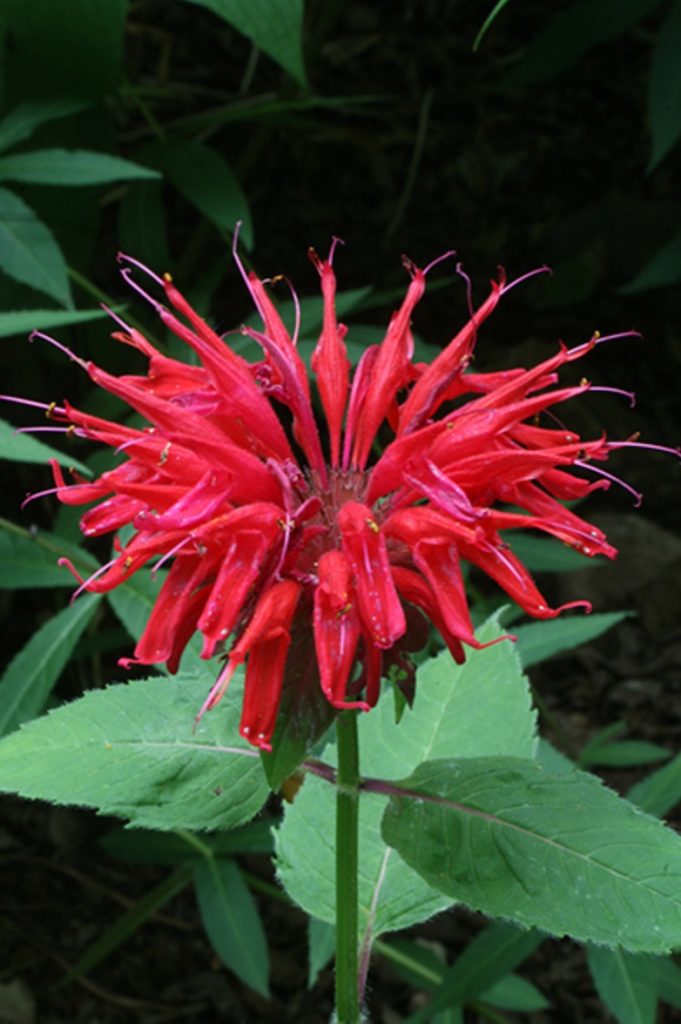
- Native
- Grows in zones 4 to 7
- Full shade to part shade and part Sun to full Sun
- Reaches 3 to 5 feet tall
- Bright Red tubular flowers in rounded clusters
- Blooms begin in June, July, and August
- Tolerates sandy, loam, and clay soil conditions
- Attracts many pollinators including birds and hummingbirds
Red Bee Balm or Monarda didyma is also known as Scarlet Beebalm, American Beebalm, and Oswego Tea. A pollinator favorite, Beebalm’s red bloom makes it especially attractive to hummingbirds. A native to the Appalachian Mountains, some of the birds you may are these:
Blue Jays * Crows * Chickadees & Titmice * Cardinals & Grosbeaks * Hummingbirds * Mockingbirds & Thrashers * Nuthatches * Orioles * Sparrows * Thrushes * Vireos * Waxwings * Woodpeckers * Wood Warblers * Wrens
19. Smooth Blue Aster Symphyotrichum laeve
- Native
- Grows in zones 3 to 9
- Part shade and part Sun to full Sun
- Reaches 4 feet tall
- Violet Blue flowers with yellow centers with blue green foliage
- Blooms appear from August, September, and through October
- Bee friendly perennial that attracts butterflies and birds
- Tolerant of rock, dry soil conditions
Blue green leaves on Smooth Blue Aster are smooth to the touch which is different than most Asters. Fall blooming native plants are so important to support the wildlife in the area. Birds that you may see around the Smooth Blue Aster are:
Blue Jays * Crows * Chickadees & Titmice * Cardinals & Grosbeaks * Finches * Mockingbirds & Thrashers * Nuthatches * Orioles * Sparrows * Thrushes * Vireos * Waxwings * Woodpeckers Wood Warblers * Wrens
20. Early Sunflower Heliopsis helianthoides
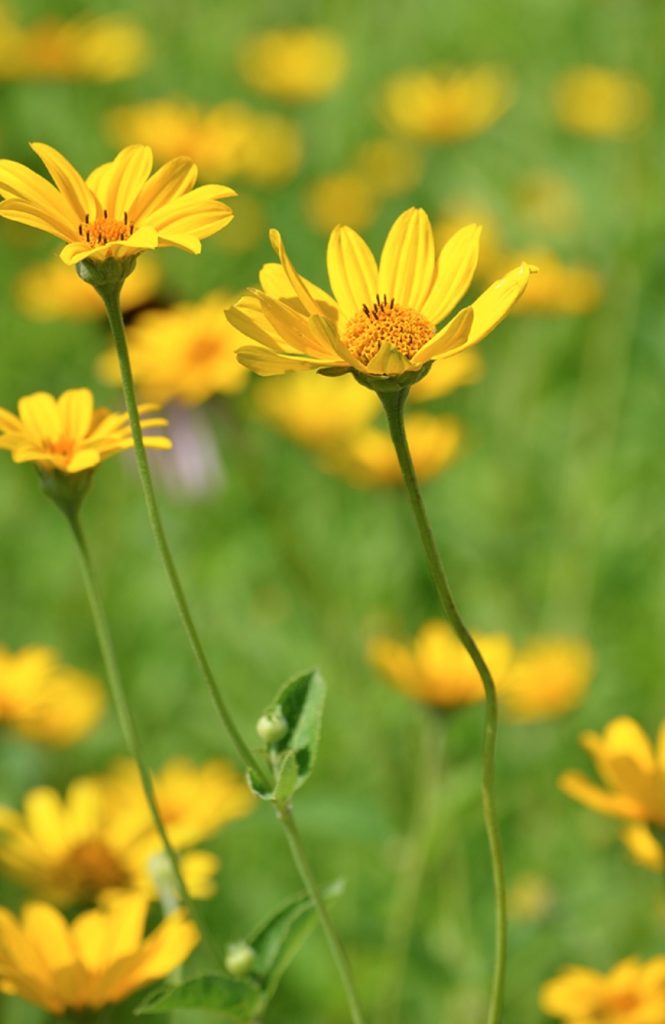
- Native
- Grows in zones 3 to 8
- Part shade and part Sun to full Sun
- Reaches 5 feet
- Yellow orange daisy-like blooms
- Blooms beginning in June, July, August, and continue through September
- Bee friendly perennial that attracts birds
- Resistant to deer
- Tolerant of dry, sandy, and clay soils
Early Sunflower or Heliopsis helianthoides, is known by many names. Some of those names include Sunflower, Sweet Smooth Oxeye, and False Sunflower. A member of the Aster family and a Spring blooming native that develops seeds from its cone-shaped disk and the ray flowers. Naturally attracting birds for the feast. Birds that you may see are:
Mockingbirds & Thrashers * Orioles * Sparrows * Vireos * Waxwings * Wood Warblers
21. Wild Geranium Geranium maculatum
- Native
- Grows in zones 3 to 8
- Shade to part shade and part Sun to full Sun
- Reaches 12 inches in height
- Pinkish purple blooms
- Blooms begin in April, May, June, and continue into July
- Bee friendly native plant that attracts birds
Wild Geranium is also known as Spotted Crane’s Bill or Spotted Geranium. A native from most of the eastern North America, Wild Geranium is mostly found in the woodlands. Easily spreads through seed. Birds that will visit the Wild Geranium are:
Blue Jays * Crows * Chickadees & Titmice * Cardinals & Grosbeaks * Finches * Mockingbirds & Thrashers * Nuthatches * Orioles * Sparrows * Thrushes * Vireos * Waxwings * Woodpeckers Wood Warblers * Wrens
22. Spotted Touch-me-not Impatiens capensis

Spotted Touch-me-not Impatiens capensis
- Native
- Annual self-seeding
- Part shade and part Sun to full Sun
- Reaches 4 feet tall
- Small Orange flowers
- Blooms in June, August, and September
- Attracts hummingbirds during Fall migration
- Resistant to deer
- Prefers medium to wet soil conditions
Spotted Touch-me-not is also known by several names. Some are called Jewelweed Impatiens capensis, Orange Jewelweed, Orange Touch-me-not, or simply known as Jewelweed. Many people show interest in the Touch-me-not because they believe it to be an antidote to Poison Ivy and Stinging Nettle. Birds that you may see by this annual are:
Blue Jays * Crows * Chickadees & Titmice * Cardinals & Grosbeaks * Finches * Hummingbirds * Mockingbirds & Thrashers * Orioles * Sparrows * Vireos * Waxwings * Woodpeckers * Wood Warblers
23. Swamp Milkweed Asclepias incarnata

Swamp Milkweed Ice Ballet
- Native
- Grows in zones 3 to 9
- Reaches 3 to 4 feet tall
- Full Sun
- Fragrant White blooms
- Blooms in the Summer
- Attracts pollinators including bees, butterflies, birds, and hummingbirds
- Resistant to deer
- Prefers moist or wet soil
Host plant for the Monarch butterflies. Birds that are typically seen around the Swamp Milkweed Ice Ballet are:
Blue Jays * Crows * Chickadees & Titmice * Cardinals & Grosbeaks * Finches * Mockingbirds & Thrashers * Nuthatches * Orioles * Sparrows * Thrushes * Vireos * Waxwings * Woodpeckers Wood Warblers * Wrens
Swamp Milkweed Cinderella
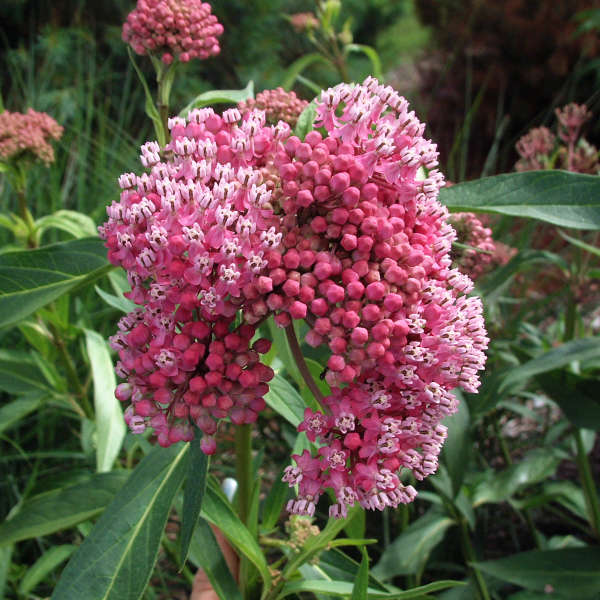
- Native
- Grows in zones 3 to 9
- Full Sun
- Reaches 3 to 4 tall
- Fragrant small clusters of Pink to mauve flowers
- Blooms in Summer
- Attracts pollinators including bees, butterflies, hummingbirds, and birds
- Resistant to deer
Swamp Milkweed, or Pink Milkweed, provides rose-pink flowers with a vanilla scent to the garden. A valuable food source for Monarch caterpillars. Birds attracted to Cinderella Swamp Milkweed are:
Blue Jays * Crows * Chickadees & Titmice * Cardinals & Grosbeaks * Finches * Mockingbirds & Thrashers * Nuthatches * Orioles * Sparrows * Thrushes * Vireos * Waxwings * Woodpeckers Wood Warblers * Wrens
24. Sweet Joe Pye Weed Eupatorium purpureum
- Native
- Grows in zones 3 to 8
- Shade to part shade and part Sun to full Sun
- Reaches 4 to 6 feet tall
- Pink blooms
- Blooms begin in August to September
- Tolerates loam, sand, and clay soil conditions
- Beneficial for pollinators including bees, butterflies, and birds
- Resistant to deer
- Host plant
Sweet Joe Pye is also known as Purple Joe Pye Weed. An especially important source of nectar for Monarchs, Swallowtails and other butterflies. Attractive seed heads develop that persist well into winter. Birds that you may see by Sweet Joe Pye are:
Blue Jays * Crows * Chickadees & Titmice * Cardinals & Grosbeaks * Mockingbirds & Thrashers * Nuthatches * Orioles * Sparrows * Thrushes * Vireos * Waxwings * Woodpeckers * Wood Warblers * Wrens
25. Tall Coreopsis Coreopsis tripteris

- Native
- Grows in zones 4 to 8
- Part shade and part Sun to full Sun
- Reaches 7 feet tall
- Yellow blooms
- Blooms from July, August, September, and into October
- Bee friendly plant that attracts butterflies and birds
- Resistant to deer
Tall Coreopsis is also known as Tickseed, Prairie Coreopsis, and Lance-leaved Coreopsis. Birds that are attracted to Tall Coreopsis are:
Blue Jays * Crows * Chickadees & Titmice * Cardinals & Grosbeaks * Finches * Mockingbirds & Thrashers * Nuthatches * Orioles * Sparrows * Vireos * Waxwings * Woodpeckers * Wood Warblers
26. Hollow Joe Pye Weed – Eutrochium fistulosum
- Native
- Grows in zones 4 to 9
- Shade to part shade and part Sun to full Sun
- Reaches 6 feet tall
- Clusters of bright pink purple blooms
- Blooms appear July, August, and through September
- Bee Friendly plant that attract butterflies and birds
- Resistant to deer
- Tolerates sandy, loam, and clay soil conditions
- Beneficial for pollinators attracts butterflies and birds
- Serves as a host plant
Hollow Joe Pye Weed is also known by other names. Some of those names include Spotted Joe Pye Weed, Joe-pye Weed, Queen of the Meadow, Tall Joe Pye Weed, and Trumpetweed. The large pink purple-domed flowerheads are a huge attraction to butterflies. Loved by many pollinators and supports various types of caterpillars which birds love to feed on. Native to the eastern half of the US, Hollow Joe Pye Weed is a member of the Aster family. Birds that are attracted to Hollow Joe Pye include:
Blue Jays * Crows * Chickadees & Titmice * Cardinals & Grosbeaks * Mockingbirds & Thrashers * Nuthatches * Orioles * Sparrows * Thrushes * Vireos * Waxwings * Woodpeckers * Wood Warblers * Wrens
27. Turk’s Cap Lily Bulbs (Lilium superbum)

- Native
- Grows in zones 3 to 9
- Part shade and part Sun to full Sun
- Reaches 12 to 24 inches tall
- Fragrant Spotted Orange blooms
- Blooms early to late Summer
- Attracts moths, butterflies, and hummingbirds
- Tolerant of moist soil conditions
The native Turk’s Cap Lily attract birds such as the following:
Hummingbirds * Mockingbirds & Thrashers * Orioles * Sparrows * Vireos * Waxwings * Wood Warblers *
28. White Turtlehead Chelone glabra
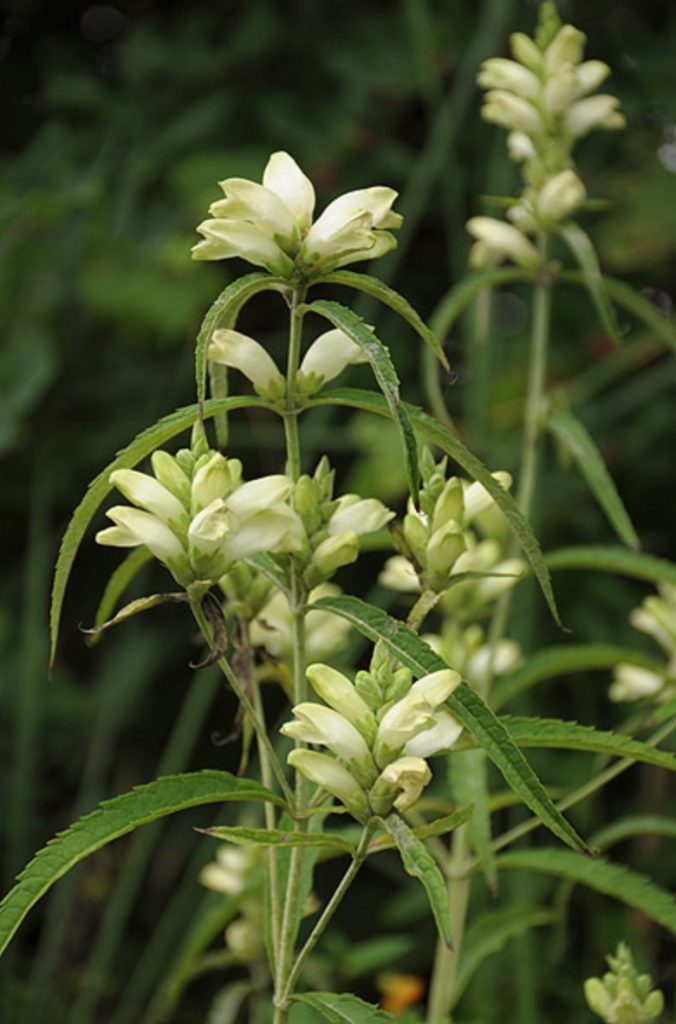
- Native
- Grows in zones 3 to 8
- Part shade and part Sun to full Sun
- Reaches 2 to 4 feet tall
- White blooms that resemble a turtle’s head
- Blooms August and September
- Tolerates sand, loam, and clay soil conditions
- Prefers wet to moist soils
- Attracts butterflies, birds, and hummingbirds
- Larval host plant for the Baltimore Checkerspot Butterfly
Blooms are pollinated mostly by bumblebees, as they have the size and strength to pry open the bloom and reach the nectar inside. An excellent plant for a butterfly habitat. The White Turtlehead attracts these birds:
Blue Jays * Crows * Chickadees & Titmice * Cardinals & Grosbeaks * Hummingbirds * Mockingbirds & Thrashers * Nuthatches * Orioles * Sparrows * Thrushes * Vireos * Waxwings * Woodpeckers Wood Warblers * Wrens
29. Whorled Milkweed Asclepias verticillata
- Native
- Grows in zones 3 to 9
- Part shade and part Sun to full Sun
- Reaches 2 feet tall
- Small clusters of greenish white flowers blooms
- Blooms July, August, and September
- Beneficial for pollinators including bees, butterflies, and birds
- Resistant to deer and rabbits
- Tolerates dry, sandy, clay, and rocky soil conditions
- Host plants for Monarch butterflies
Nectar from the Whorled Milkweed flowers attracts many kinds of insects. Including the long-tongued bees, short-tongued bees, wasps, flies, butterflies, skippers, and beetles. Asclepias verticillata or Whorled Milkweed has very skinny, whorled leaves. Birds that are attracted to this milkweed are:
Blue Jays * Crows * Chickadees & Titmice * Cardinals & Grosbeaks * Mockingbirds & Thrashers * Nuthatches * Orioles * Sparrows * Thrushes * Vireos * Waxwings * Woodpeckers Wood Warblers * Wrens
30. Wild Blue Phlox Phlox divaricata

Wild Blue Phlox Phlox divaricata
- Native
- Wild Blue Phlox has five petals.
- Grows in zones 3 to 8
- Shade to part shade and part Sun
- Reaches 12 inches tall
- Fragrant 5 petal Blue blooms
- Blooms April, May, and June
- Bee friendly and attracts butterflies, hummingbirds, and birds
- Tolerates sandy, loamy, and clay soils
- Resistant to deer
Wild Blue Phlox or Phlox divaricata is also commonly called Blue Phlox, Blue Woodland Phlox, or Louisiana Phlox. And at times, Sweet William. Blooms are pale blue to lavender and even violet in color. A semi-evergreen that is a nectar source for butterflies and hummingbirds. Birds that you will with the Wild Blue Phlox are:
Blue Jays * Crows * Chickadees & Titmice * Cardinals & Grosbeaks * Hummingbirds * Mockingbirds & Thrashers * Nuthatches * Orioles * Sparrows * Thrushes * Vireos * Waxwings * Woodpeckers * Wood Warblers * Wrens
31. Woodland Sunflower Helianthus divaricatus
- Native
- Grows in zones 5 to 9
- Shade to part shade and part Sun
- Reaches 4 feet tall
- Yellow blooms
- Blooms in July, August, September
- Attracts birds and butterflies
Woodland Sunflower attracts the following birds:
Blue Jays * Crows * Chickadees & Titmice * Cardinals & Grosbeaks * Mockingbirds & Thrashers * Nuthatches * Orioles * Sparrows * Thrushes * Vireos * Waxwings * Woodpeckers Wood Warblers * Wrens
This ends our list of Native Plants that attract birds. As a reminder, pollinator gardens should have a variety of plants that bloom all three seasons. As well as plants that provide berries or seeds over the Winter months, too. Pollinator gardening is a year round effort to feed our birds and other wildlife.
Finally, we hope that you are able to try a few of these native plants in your garden. And with native plants you have the added benefit of enjoying the many birds and wildlife that visit your garden.
Interested in gardening for pollinators? If you found this helpful . . .
You May Also Enjoy some of our other pollinator gardening related posts.
Plants that Attract Monarch Butterflies
Host Plants for Monarch Butterflies
Plants that Attract Hummingbirds
15 Bee Friendly Perennials to Make Your Garden Buzz
And if you have any questions, feel free to reach out to us. We always are ready to help you out. Thank you for dropping by.
Mary

